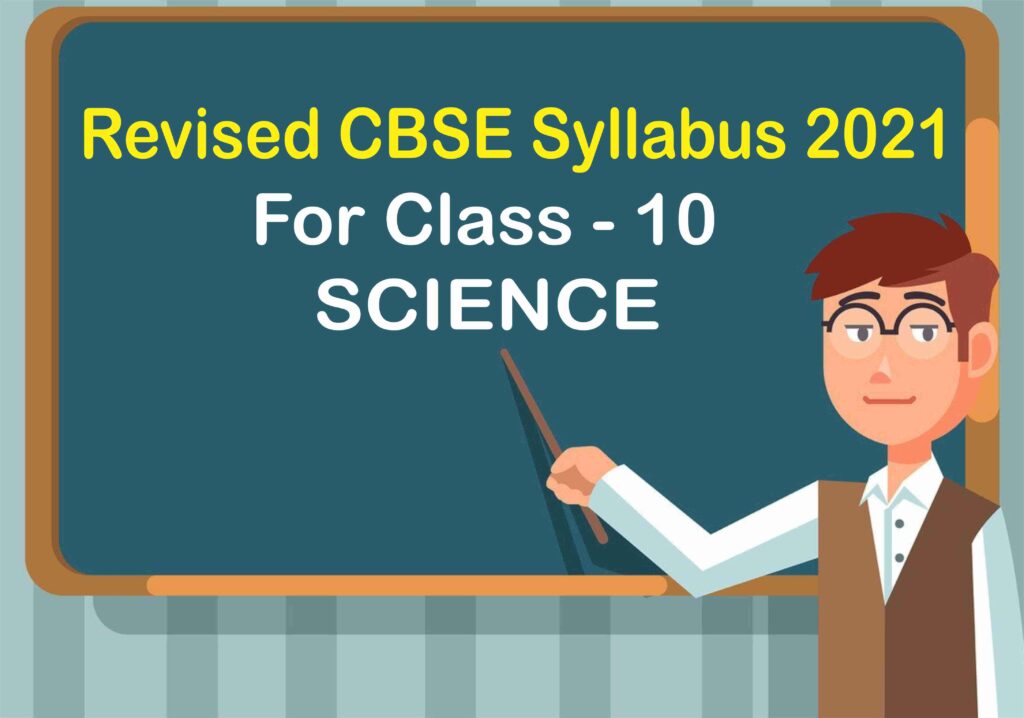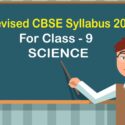Revised CBSE Syllabus 2021 for Class 10 Science
The subject of Science plays an important role in developing well-defined abilities in cognitive, affective and psychomotor domains in children. It augments the spirit of enquiry, creativity, objectivity and aesthetic sensibility.
Upper primary stage demands that a number of opportunities should be provided to the students to engage them with the processes of Science like observing, recording observations, drawing, tabulation, plotting graphs, etc., whereas the secondary stage also expects abstraction and quantitative reasoning to occupy a more central place in the teaching and learning of Science. Thus, the idea of atoms and molecules being the building blocks of matter makes its appearance, as does Newton’s law of gravitation.
The present syllabus has been designed around seven broad themes viz. Food; Materials; The World of the Living; How Things Work; Moving Things, People and Ideas; Natural Phenomenon and Natural Resources. Special care has been taken to avoid temptation of adding too many concepts than can be comfortably learnt in the given time frame. No attempt has been made to be comprehensive.
At this stage, while science is still a common subject, the disciplines of Physics, Chemistry and Biology begin to emerge. The students should be exposed to experiences based on hands on activities as well as modes of reasoning that are typical of the subject.
General Instructions:
- There will be an Annual Examination based on the entire
- The Annual Examination will be of 80 marks and 20 marks weightage shall be for Internal
- For Internal Assessment:
- There will be Periodic Assessment that would include:
- For 5 marks- Three periodic tests conducted by the school. Average of the best two tests to be taken that will have a weightage of 05 marks towards the final
- For 5 marks- Diverse methods of assessment as per the need of the class dynamics and curriculum transaction. These may include – short tests, oral test, quiz, concept maps, projects, posters, presentations, enquiry based scientific investigations etc. This will also have a weightage of 05 marks towards the final result.
- There will be Periodic Assessment that would include:
- Subject Enrichment in the form of Practical / Laboratory work should be done
throughout the year and the student should maintain record of the same. Practical Assessment should be continuous. There will be weightage of 5 marks towards the final result. All practicals listed in the syllabus must be completed.
- Portfolio to be prepared by the student- This would include classwork and other sample of student work and will carry a weightage of 5 marks towards the final results.
COURSE STRUCTURE CLASS X
(Annual Examination)
Marks: 80
| Unit
No. |
Unit | Marks |
| I | Chemical Substances-Nature and Behaviour | 26 |
| II | World of Living | 23 |
| III | Natural Phenomena | 12 |
| IV | Effects of Current | 14 |
| V | Natural Resources | 05 |
| Total | 80 | |
| Internal assessment | 20 | |
| Grand Total | 100 |
Theme: Materials
Unit I: Chemical Substances – Nature and Behaviour
Chemical reactions: Chemical equation, Balanced chemical equation, implications of a balanced chemical equation, types of chemical reactions: combination, decomposition, displacement, double displacement, precipitation, neutralization, oxidation and reduction.
Acids, bases and salts: Their definitions in terms of furnishing of H+ and OH– ions, General properties, examples and uses, concept of pH scale (Definition relating to logarithm not required), importance of pH in everyday life; preparation and uses of Sodium Hydroxide, Bleaching powder, Baking soda, Washing soda and Plaster of Paris.
Metals and nonmetals: Properties of metals and non-metals; Reactivity series; Formation and properties of ionic compounds.
Carbon compounds: Covalent bonding in carbon compounds. Versatile nature of carbon. Homologous series.
Periodic classification of elements: Need for classification, early attempts at classification of elements (Dobereiner’s Triads, Newland’s Law of Octaves, Mendeleev’s Periodic Table), Modern periodic table, gradation in properties, valency, atomic number, metallic and non-metallic properties.
Theme: The World of the Living Unit II: World of Living
Life processes: ‘Living Being’. Basic concept of nutrition, respiration, transport and excretion in plants and animals.
Reproduction: Reproduction in animals and plants (asexual and sexual) reproductive health- need and methods of family planning. Safe sex vs HIV/AIDS. Child bearing and women’s health.
Heredity: Heredity; Mendel’s contribution- Laws for inheritance of traits: Sex determination: brief introduction;
Theme: Natural Phenomena Unit III: Natural Phenomena
Reflection of light by curved surfaces; Images formed by spherical mirrors, centre of curvature, principal axis, principal focus, focal length, mirror formula (Derivation not required), magnification.
Refraction; Laws of refraction, refractive index.
Refraction of light by spherical lens; Image formed by spherical lenses; Lens formula (Derivation not required); Magnification. Power of a lens.
Refraction of light through a prism, dispersion of light, scattering of light, applications in daily life.
Theme: How Things Work Unit IV: Effects of Current
Electric current, potential difference and electric current. Ohm’s law; Resistance, Resistivity, Factors on which the resistance of a conductor depends. Series combination of resistors, parallel combination of resistors and its applications in daily life. Heating effect of electric current and its applications in daily life. Electric power, Interrelation between P, V, I and R. Magnetic effects of current : Magnetic field, field lines, field due to a current carrying conductor, field due to current carrying coil or solenoid; Force on current carrying conductor, Fleming’s Left Hand Rule, Electric Motor, Electromagnetic induction. Induced potential difference, Induced current. Fleming’s Right Hand Rule.
Theme: Natural Resources Unit V: Natural Resources
Our environment: Eco-system, Environmental problems, Ozone depletion, waste production and their solutions. Biodegradable and non-biodegradable substances.
ONLY FOR INTERNAL ASSESSMENT
Note: Learners are assigned to read the below listed part of Unit V. They can be encouraged to prepare a brief write up on any one concept of this Unit in their Portfolio. This may be an assessment for Internal Assessment and credit may be given (Periodic
assessment/Portfolio). This portion of the Unit is not to be assessed in the year-end examination.
Management of natural resources: Conservation and judicious use of natural resources. Forest and wild life; Coal and Petroleum conservation. Examples of people’s participation for conservation of natural resources. Big dams: advantages and limitations; alternatives, if any. Water harvesting. Sustainability of natural resources.
PRACTICALS
Practical should be conducted alongside the concepts taught in theory classes LIST OF EXPERIMENTS
- Studying the properties of acids and bases (HCl & NaOH) on the basis of their reaction with
- Litmus solution (Blue/Red) Unit-I
- Zinc metal
- Solid sodium carbonate
- Performing and observing the following reactions and classifying them into: Unit-I
- Combination reaction
- Decomposition reaction
- Displacement reaction
- Double displacement reaction
- Action of water on quicklime
- Action of heat on ferrous sulphate crystals
- Iron nails kept in copper sulphate solution
- Reaction between sodium sulphate and barium chloride solutions
- Observing the action of Zn, Fe, Cu and Al metals on the following salt solutions: Unit-I
- ZnSO4(aq)
- FeSO4(aq)
- CuSO4(aq)
- Al2 (SO4)3(aq)
Arranging Zn, Fe, Cu and Al (metals) in the decreasing order of reactivity based on the above result.
- Studying the dependence of potential difference (V) across a resistor on the current (I) passing through it and determining its resistance. Also plotting a graph between V and Unit-IV
- Experimentally show that carbon dioxide is given out during Unit-II
- Determination of the focal length of (i) Concave mirror and (ii) Convex lens by obtaining the image of a distant Unit-III
- Tracing the path of a ray of light passing through a rectangular glass slab for different angles of incidence. Measure the angle of incidence, angle of refraction, angle of emergence and interpret the Unit – III
- Studying (a) binary fission in Amoeba, and (b) budding in yeast and Hydra with the help of prepared Unit-II
- Tracing the path of the rays of light through a glass Unit-III
PRESCRIBED BOOKS:
- Science-Text book for class X- NCERT Publication
- Assessment of Practical Skills in Science- Class X- CBSE Publication
- Laboratory Manual-Science-Class X, NCERT Publication
- Exemplar Problems Class X – NCERT Publication
Assessment Areas (Theory) 2020-21
(Class X)
Science (086)
Time: 3 hrs. Maximum Marks: 80
| Competencies | |
| Demonstrate Knowledge and Understanding | 46 % |
| Application of Knowledge/Concepts | 22 % |
| Analyze, Evaluate and Create | 32 % |
Note:
- Typology of Questions: VSA including objective type questions, Assertion – Reasoning type questions; SA; LA; Source-based/ Case-based/ Passage-based/ Integrated assessment questions.
- An internal choice of approximately 33% would be
Internal Assessment (20 Marks)
- Periodic Assessment – 05 marks + 05 marks
- Subject Enrichment (Practical Work) – 05 marks
- Portfolio – 05 marks
Demonstrate Knowledge and Understanding
Suggestive verbs for various competencies
State, name, list, identify, define, suggest, describe, outline, summarize, etc.
- Application of Knowledge/Concepts
Calculate, illustrate, show, adapt, explain, distinguish, etc.
- Analyze, Evaluate and Create
Interpret, analyze, compare, contrast, examine, evaluate, discuss, construct, etc.

